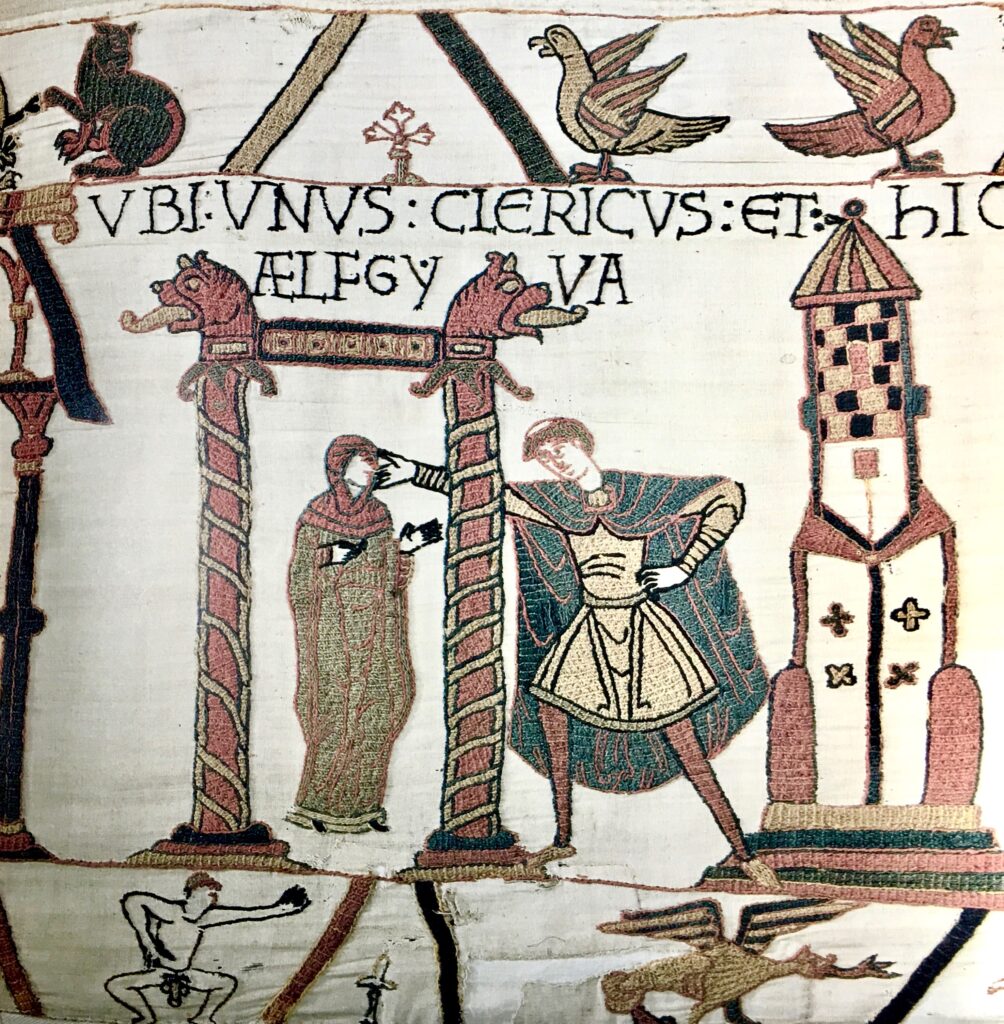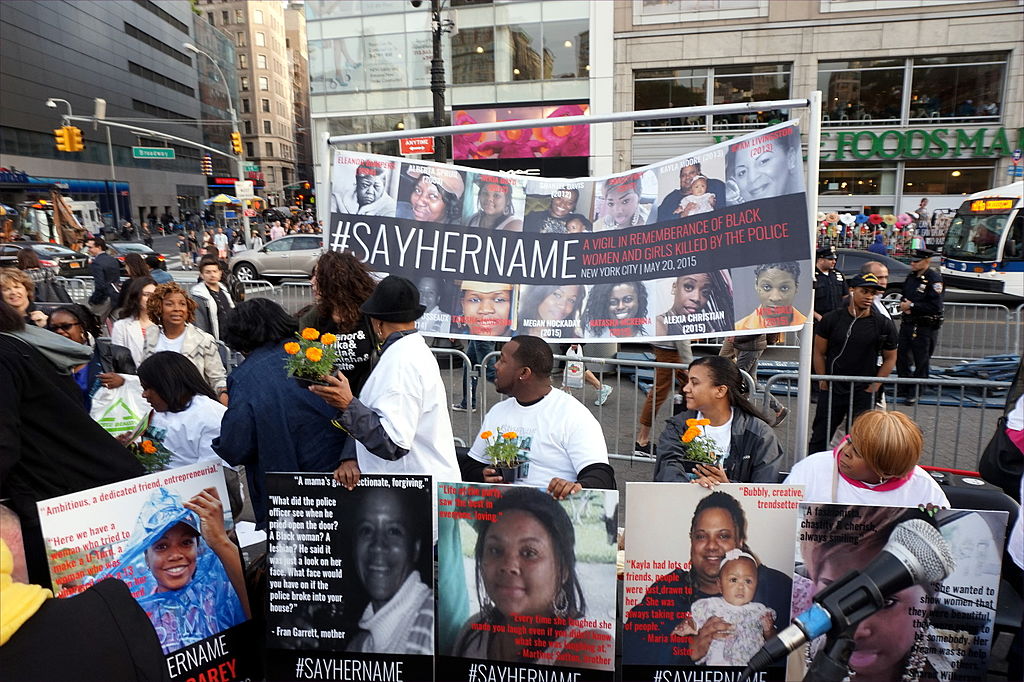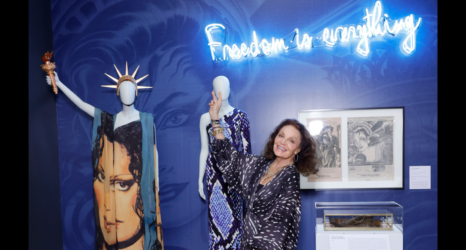We can never gather all the facts of any story that enters the public consciousness. What we can do is resist reducing our assumptions to the oldest nouns at hand—the ones that imprison women in two dimensions of male design.

The woman is inside, framed in a doorway. She’s fully cloaked and wears a headscarf; only her hands and face are visible. Her arms are open, palms tilted up—a universal gesture, but of what? Protest? Surprise? Welcome?
The man, a monk, is outside. His left hand is on his hip, hissy fit style. He lunges toward the woman and penetrates her space, touching her face with his right hand. Is it a slap…or a caress?
No one knows. The pair lived a thousand years ago, but like insects trapped in amber, we can still see them, borne through time far from their few short years of life and breath. I feel for them—they didn’t ask for immortality—and I almost want to look away, but I never do.
The woman and monk were embroidered into the Bayeux Tapestry in rich, vegetable-toned yarns in the years following William of Normandy’s invasion of Britain, in 1066. The Tapestry tells the story—skewed to William’s conquering point of view—of how he vanquished King Harold of England at the Battle of Hastings.
It’s a rousing boys’ adventure: broken oaths and feasting, ships braving the English channel, a brutal battle scene strewn with body parts, chainmail, and upended horses. Of the 626 human figures depicted, three are female. The Queen of England, a refugee escaping battle, and AElfgyva, the woman in the doorway: an enigma with a name.
The Bayeux Tapestry is 230 feet long and under two feet wide. A football field is only 160 feet long, so that should give you a sense of the immense, thundering onrush of William’s narrative. Yet towards the beginning it rams smack into AElfgyva and comes to a screeching halt:
“VBI VNVS CLERICVS ET AELFGYVA.”
The Latin text above the image of the lady and monk reads, “Here a Certain Cleric and AElfgyva.” After their encounter, the story gallops forward towards conquest.
That’s all we’ve got. Actually, not quite—a tiny, naked man, genitalia on full display, squats in the margin below AElfgyva’s feet, mimicking the monk’s gesture in reverse. At one time her story clearly carried powerful significance for its viewers, but like the meaning of Stonehenge, we’ve clean forgotten what it was.
I don’t know what happened between AElfgyva and her monk, but I do know that when I encountered the Bayeux Tapestry in college, over 30 years ago, AElfgyva leapt straight off the linen into my life. She’s resonated there ever since. She’s never been a mystery I’ve needed to solve; what’s engaged me all this time is how history has treated her.
“…the cleric may be making a pass, or slapping the woman for having impure thoughts or for being a witch,” writes David Wilson, commentator on a Knopf facsimile of the tapestry.
Male opinion down the ages has allowed just a trinity of identities, as I discovered reading about AElfgyva in college. In text after text I read, “we must surmise” she was a victim, whore or witch. Apparently, those are the only roles open to women who ride the centuries with insufficient personal stories.
What really happened? All we can say is that someone did something to her, or she did something to thwart 11th century conventions of female behavior. Yet based on her scene in the tapestry, she’s been reduced to those three nouns, no more: Victim, Whore, Witch.
Think that’s just male scholars sitting in judgment of women in medieval tapestries? Think again.
Think of Breonna Taylor: “Breonna Taylor Is a Victim of Bad Decision Making.”
Think of Christine Blasey Ford: “CRTV’s Steven Crowder: Christine Blasey Ford is a ‘lying whore.’”
Think of Meghan Markle, now Duchess of Sussex: “Meghan Markle Called ‘Witch,’ Prince Harry Under Her Spell.”
AElfgyva the individual has vanished, but AElfgyva the template—a silhouette stitched in yarn, like the chalk outline of a body—is very much with us, and we’re still filling it with the same trinity of nouns. We don’t use tapestries to tell our stories anymore, but even in our 24/7 news cycle, we can never have omniscient knowledge of “what happened” to any of these women, even if they’re our immediate contemporaries. They’re not fictional characters and we’re not authors; we lack sufficient stories. And so we fill in the news with shorthand.
What we need to examine is the kind of shorthand we use, and who dictates it.
The media and the public pretty much agree that Breonna Taylor—the young Black woman shot and killed by police in her own apartment during a botched drug raid this past March—was a victim. Most agree she was an innocent victim; some, like Jason Whitlock of the You Tube program, Fearless, feel that she was the victim of her own bad decisions.
However you fill in her story, her image—like AElfgyva’s—has taken on iconic status in the absence of the living woman. The shorthand remains in place and Taylor’s agency is quashed.
In 2018, Professor Christine Blasey Ford accused then Supreme Court nominee, Brett Kavanaugh, of sexually assaulting her when they were teenagers. As soon as she agreed to appear before the Senate Judiciary Committee to tell her story, the shorthand machine got to work. Despite Ford being “100% certain” that it was Kavanaugh who attacked her, Republican senators undermined and disregarded her story and she was openly mocked by President Trump, who questioned her credibility. Conservative commentator Steven Crowder went further, calling her a “lying whore.”
Meghan, Duchess of Sussex, infamously opted out of the British Royal Family earlier this year along with her husband, Harry, Duke of Sussex. As if there could have been no other explanations for their decision–not the British press’s hounding of the couple, as they hounded Harry’s mother, Diana; not the implicit (and sometimes explicit) racism brewing around the biracial Meghan–many declared the couple’s exit to be solely Meghan’s initiative. Conservative American writer, Candace Owens, succinctly explained how she convinced her husband to leave Britain: “Meghan Markle is a witch. Harry is under her spell.” Many readers responded online: “Couldn’t agree more.”

The medium has changed but not the message. If AElfgyva could speak to us she’d probably say, “#MeToo.” If I could speak for her I’d add, “#SayHerName” (it’s pronounced something like “ELV-jiva,” and means “gift of the elves”).
We can never gather all the facts of any story that enters the public consciousness. What we can do is resist reducing our assumptions to the oldest nouns at hand. The ones that have been around for a thousand years or more—the ones that imprison women in two dimensions of male design.
You may also like:
Our opponents are using the lame duck period—the time between now and when the new president is inaugurated, and a new Congress convenes—to do as much damage as they can. Help ensure Ms. remains strong and independent during this period of challenge and change. If you found this article helpful, please consider supporting our independent reporting and truth-telling for as little as $5 per month.





